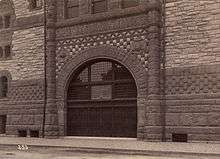Exeter Street Theatre
The Exeter Street Theatre is a Richardsonian Romanesque building at the corner of Exeter and Newbury Streets, in the Back Bay section of Boston, Massachusetts. It was built as the First Spiritual Temple, 1884–85, by architects Hartwell and Richardson.[1] For seventy years, from 1914 to 1984, it operated as a movie house. It now houses the Kingsley Montessori School.
History


"Wealthy socialite Mrs. [Marcellus Ayers] and her friends" organized the conversion in 1914 of church into cinema;[2] Clarence Blackall designed the renovation.[3] It "could accommodate 900 patrons."[4][5] Proprietors and overseers included Viola and Florence Berlin,[6] and Neil St. John Raymond.[3]
After the theatre closed in 1984 amidst popular cultural anguish and bottom-line real-estate concerns, the building has been deployed for a variety of mostly commercial purposes.[7] It was occupied by Conran's housewares retailer and Waterstones booksellers.[8] By 1988 "the Exeter Street Theatre building [housed] Friday's Restaurant and an office complex."[9] Business consultants Idealab leased space in the building from 2000 to 2003.[10][11] In 2005 it became the Kingsley Montessori School.[12]
One of the cinema's electric signs, scrapped in 1985, was acquired by collector Dave Waller.[13][14]
John Cheever's short story "The President of the Argentine" mentions the Exeter Street Theatre.[15]
Screenings

1910s
1920s
- A Virtuous Vamp[17]
- Haunting Shadows[17]
- Robert Z. Leonard's Stronger Than Death[17]
- Live Sparks[17]
- Passion Flower[18]
- Just Out of College[18]
- Sowing the Wind[18]
- Haunted Spooks[18]
- Pink Gods[19]
- The Man Who Saw Tomorrow[19]
- East is West[19]
1980s
- Lynne Littman's Testament[20]
- The Leopard[21]
- "The Man Who Skied Down Everest"[22]
References
- ↑ http://www.fst.org/temple.htm
- ↑ Russell Merritt. "Nickelodeon Theaters, 1905-1914." In: Thomas Schatz, ed. Hollywood: critical concepts in media and cultural studies. Taylor & Francis, 2004
- 1 2 Jane Holtz Kay. "The Last Picture Show at the Exeter." Boston Globe, April 3, 1984
- ↑ A. Scott Berg. Goldwyn: a biography. Penguin, October 1, 1998
- ↑ "Lively hearing on movie censorship; mayor feels Boston needs no aid from state -- labor and theatre men oppose." Boston Globe, February 25, 1920
- ↑ Mark Feeney. "When Boston was home to many lavish theaters: Hub’s heyday of theaters is recalled." Boston Globe, Jan. 8, 2012
- ↑ Lynnley Browning. "Staples, others eyeing historic Exeter Street edifice." Boston Globe, January 13, 2000
- ↑ Waterstone's closing chapter. Boston Globe, May 25, 1999
- ↑ Michael Blowen. "The changing Boston cinema: more screens, less art." Boston Globe, October 9, 1988
- ↑ Scott Kirsner. "Incubator Smackdown". Boston Globe, November 6, 2000
- ↑ Peter Howe. "Idealab to shut Boston office." Boston Globe, May 10, 2003
- ↑ Jill Gross. "Evolution: movies, books, kids: ex-Exeter Theatre is reborn as Montessori." Boston Globe, October 23, 2005
- ↑ Nathan Cobb. "Dave Waller's sign collection sheds bright light on bygone times." Boston Globe, May 24, 2003
- ↑ Robert Preer. "Old signs have a home." Boston Globe, January 18, 2009
- ↑ Atlantic Monthly, April 1976. Discussed in: Douglass Shand-Tucci. The Crimson Letter: Harvard, Homosexuality, and the Shaping of American Culture. Macmillan, 2004
- 1 2 "Mary Pickford Week." Moving Picture World, February 12, 1916
- 1 2 3 4 Boston Globe, February 10, 1920
- 1 2 3 4 Boston Globe, June 7, 1921
- 1 2 3 Boston Globe, December 12, 1922
- ↑ The Boston Phoenix - November 8, 1983
- ↑ Boston Globe, January 15, 1984
- ↑ indelible personal memory of contributor
Further reading
- "Boston time capsule opened after 100 years." Bangor Daily News - September 23, 1985
External links
| Wikimedia Commons has media related to |
- Flickr. Photos of the building, 1984
- Exterior
- Exterior
- Sign holder
- Interior
- Stained glass window, interior
Coordinates: 42°21′1.81″N 71°4′48.07″W / 42.3505028°N 71.0800194°W